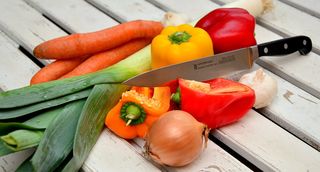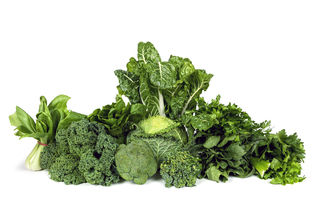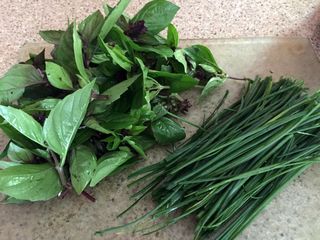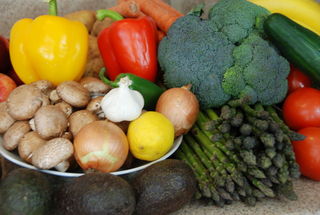For two years on my journey of healthy, wholesome, plant-based eating, I had the pleasure of experiencing a CSA — Community Supported Agriculture — food share program. If you are not yet familiar with them, I share all about it and my experience with a CSA farm in this article.
That was back in 2010, and since then, a lot has changed. First, CSA food share programs have become much more popular and more widely available throughout North America. Second, as unfortunate circumstances go, my CSA farmer’s personal circumstances changed, and he had to let go of the CSA program and his farm work for a few years. Not being able to have access to a CSA food share any longer, however, ended up being a positive thing for me, as it inspired me to grow my own food.
As I live and teach, if one of our life priorities is our health, then nothing aside from the state of our mind is more important than healthy, wholesome, high-quality food. Given how our modern-day societies currently operate, most people, especially in today’s world, will not become farmers or have the ability or even desire to grow their own food. This is where authentic CSA programs are paramount, as they can provide us with the freshest, local, seasonal, and often organic food possible.
To help you become more informed, interested, and excited about the amazing food, health, environmental and economic benefits of CSA programs, here are my top 10 benefits of a CSA food share program.
1. You get access to the freshest produce possible.
Most fruits and vegetables in grocery stores today travel to us large distances from far away places. The food may not be seasonal for us and is most often picked unripe, which means it doesn’t reach its full nutritional potential the way it would if it was picked when properly mature.
On the other hand, as part of a CSA food share, you normally get food that was picked within 24 hours and at its perfect time of maturity. This means it will provide you its highest nutrient density, with optimum levels of vitamins, minerals, antioxidants, phytonutrients, and life energy. In the CSA I was a part of, the food was literally picked just a few hours before it arrived at our house. And that kind of freshness and quality is highly attractive and palpable to our senses of sight, smell, touch, and taste.
2. You get access to local food.
Given the challenges we face environmentally on our Earth today, there is a growing awareness and understanding of the value of local economies, especially when it comes to our food. Local food will usually provide the most environmentally responsible way to get our food, instead of hauling it long distances where massive amounts of fossil fuels and unnecessary efforts are involved. Of course, it is not sustainable to try to grow certain foods in certain regions, like tropical fruits in northern climates, and thus transport is utilized in such cases. However, we should always remember that getting tropical fruits to northern climates is a tremendous privilege and by no means a given or a right.
Therefore, local farms focus on what would normally and naturally grow in that region, which makes it the most sustainable for our Earth. In many cases, where a variety of plant foods, like fruits, vegetables, grains, and legumes can grow naturally, it can also be the healthiest way to eat, as the food grown in your local climate and habitat is most in alignment with your body’s needs for that particular region.
Thanks to the wonderful local CSA program, it allowed us to develop a trusted relationship and a friendship with the farmer who provided our food. We knew 100% where our food comes from and how it was grown during the season, which offered great peace of mind and an incredibly good overall feeling.
3. You get organic food.
Although this is not always guaranteed and will ultimately depend on the farm you are affiliated with, in most cases, CSA programs do offer strictly organic food. Next to fresh and local, organic food should be one of our key priorities today when it comes to healthy eating, given the amount and varieties of pesticides applied to our food today. I will be the first to say that organic food, especially on a commercial level, is by no means perfect. However, despite its limitations or imperfections, it is still many, many times better for our Earth and us than what conventional farming provides. If you are new to this topic or perhaps skeptical about the value of organic food, I encourage you to explore the following two resources:
- What’s On My Food — a directory where you can search for specific foods and learn why kinds of pesticides are on them, and risks associated with them
- EWG’s Shopper’s Guide to Pesticides in Produce — an annual report and tool to help consumers understand the worst and best produce choices when it comes to pesticide risk and contamination
We have to keep in mind, too, that to be an organic-certified farm requires some stringent guidelines to be in place and time and financial investments, which many small farms simply cannot do. Therefore, the smaller your local CSA farm is, the higher are the chances that it will be “unofficially organic” rather than officially “certified organic.” This was the case with my CSA experience, where the farmer was simply farming the way we used to before the industrial and chemical revolution. It was a pleasure to see regular insect bites in the leafy greens, holes in the corn, or some unique insects that we brought home in some veggies. The key here is to establish trust and know your farmer and how things are grown on the farm. The truth is, too, that many small farmers actually cannot afford the expenses that come with chemical pesticides and prefer to rely on natural measures, including integrated pest management, edible forests, and non-monoculture farming methods.
4. You get an excellent variety of food.
When we think about our usual weekly grocery routine, most people find themselves buying the same handful of fruits, veggies, and other foods week after week. We get into routines, we get into comfort zones, and all too often, we get stuck in a rut. However, with a CSA, you get an outstanding variety from week to week based on what is growing, mature, and ready for harvest at different times in the season. By their very nature, many CSA programs grow a wide variety of vegetables, some in warmer climates also fruits, to provide that extra benefit of variety to their CSA members. This improves the variety in your diet, provides more nutritional benefits, and can actually reduce the chances of food allergies, which can be triggered by relying too heavily on one certain food in our diet and/or eating highly unhealthy diets or those very low in variety.
Due to conventional farming over the last decade, we have severely reduced the agrobiodiversity and a variety of foods in our diets. To make matters worse, as shared in the paragraph above, we reduce that already limited variety even more based on our personal preferences, routines, and habits. According to the FAO, the last 100 years have seen about 75% of plant genetic diversity lost as farmers worldwide have left their multiple local varieties and landraces for genetically uniform, high-yielding varieties. With a CSA program, on the other hand, you can gain access to an increased variety of foods in your diet and even benefit from many heirloom varieties of fruits, veggies, and/or herbs that have more of their natural genetic integrity, and often health and nutrition benefits for us.
5. You get to try new foods, especially vegetables.
Part of that variety benefit above includes yet another benefit, where a CSA program can “force” you to try many new foods, especially vegetables. Of course, I use the word force here in the most positive of ways. Again, unfortunately, due to our rushed and routine lifestyles, many of us don’t think about or make any effort to try many, if any, new fruits, vegetables, mushrooms, grains, beans, or herbs. We stick with what we know and habitually prepare the same set of meals.
However, with a CSA, you will likely receive foods you haven’t tried before and thus be inspired to learn about them and find ways to enjoy them as part of your diet. My CSA farm grew about 50 different vegetables throughout the season, so I got to try so many new vegetables, some that I had either not heard of before, and others that I was simply too intimidated or uninspired to buy at the grocery store before. Well, now that I had them literally handed to me, it was actually fun to experience them and the new culinary flavors, textures, and exciting opportunities they offered.
6. You get to eat more greens than ever.
Leafy greens, and green vegetables in general, are one of the most important parts of an optimally healthy human diet, and something most people in today’s world do not get enough of. Greens are the most nutrient-dense foods and provide outstanding vitamin, mineral, antioxidant, phytonutrient, fiber, and alkalizing benefits. In fact, to maintain an optimal acid-alkaline balance, which is highly healing and protective against all diseases, we need lots of greens in our daily diet.
Although each CSA’s food contents and variety will vary, most provide an excellent amount of different leafy green vegetables and herbs. For example, my CSA provided an extremely rich abundance of different kale and lettuce varieties, swiss chard, collard greens, spinach, bok choy, pak choi, cabbages, cilantro, parsley, and other herbs. So much so, in fact, that I was able to have a generous amount of greens with every single one of my daily meals — green smoothies for breakfast, salads for lunch, and steamed greens in various dinner meals. This is why I considered this a time in my life during which I ate better than ever, in spite of already eating an optimally healthy whole-food, plant-based diet for years.
7. You get to eat a lot of different herbs.
As shared in the benefit above, those greens also included a wide assortment of herbs, which can include different varieties of basil, cilantro, parsley, dill, fennel, oregano, mint, tarragon, rosemary, and others. Herbs do not typically serve as the main parts of our meals or offer a significant amount of calories or energy. This is mostly due to their medicinal properties, which are often expressed by their strong flavors. This is why, for example, we base our salads on greens like lettuce or spinach, rather than cilantro or basil. Whatever leafy green herb we may be talking about, we can be sure that it will offer us an outstanding array of health and nutrition benefits, which include being highly anti-inflammatory, alkalizing, anti-cancerous, cleansing, detoxifying, and full of antioxidants. The medicinal properties of herbs are also capable of directly treating and alleviating various symptoms and disease states. This includes everything from our digestive system to our nervous system, with some herbs even being able to remove heavy metals from the body.
Sadly, most people do not eat enough, if any in some cases, of herbs. For convenience, many people also tend to rely on dry herbs, which can be just fine but won’t offer the same health and nutrition potential as their fresh counterparts. With a CSA program, you are likely to get to eat a lot of different herbs on a regular basis, as most CSAs are outstanding at providing a regular supply of different herbs. I remember coming home with large bags of basil and parsley, for example, and enjoying so many new highly healing and deliciously flavorful dishes.
8. You get to support your local economy.
At a time when so many of us are becoming more conscious about who our money supports, one of the best feelings of joining a CSA program is knowing that you are directly helping and supporting your local farmer(s). And in truth, when we think about it, these are the most important people we should be supporting to ensure their success. Globalization, industrialized farming, and the extensive transportation system may appear like they have secured food production and delivery, but the system we have is very fragile in reality. More people are increasingly learning this harsh truth as different challenges, like extreme weather and climate change, threaten our food security. If any part of the system collapses, the ripple effect can have profound consequences on our health, wellbeing, and ultimately survival. This is why one of the biggest solutions to have a truly sustainable food system is to support small, local farms, and farmers worldwide. The more we diversify our food production and bring it closer to home, the better the outcomes will be, both short and long term, especially in any state of emergency.
Therefore, being part of a CSA feels great, as you know directly who you are supporting — a small farm or farmer family who is part of the solution of healing us and our Earth versus a large corporation whose impacts are often destructive in multiple ways. For me, it was a pleasure to be able to contribute to a local farmer and have him be able to continue to support himself, his family, and other families like us in our community.
9. You get some of the best-priced produce.
Although prices for CSA programs will vary widely, being highly dependent on the geographic location and vicinity to rural versus urban or metropolitan areas, in general, most CSA programs save people money. In addition, if we factor in the higher quality of food provided, the benefits stack up even more. Even if the food ends up costing the same as it would from the grocery store or even slightly more, the benefits I have mentioned above normally still make it well worth it.
My CSA’s food share price was incredible — $375 for 18 weeks, providing a full share each week! The value offered was outstanding, to the point that it made the food almost feel free. Mind you, this was back around 2011, and my food share was based out of a small, rural community and served by a single, small farm. I felt incredibly blessed to have so much of such high-quality food for such a humble price.
10. You get to easily eat whole-food, plant-based.
Although some CSA programs provide some animal products, most focus on plants. Some farms may do only vegetables and herbs, while others include fruits, and others yet even include some local grains, beans, nuts, and seeds. This enables anyone to have easy access to high quality, whole plant foods, and eat the most healing and protective diet — a whole-food, plant-based diet. Of course, the key then is simply making sure that you use the food you get from your CSA and not let it go to waste by habitually grabbing some processed or refined convenience foods. Depending on your present diet and lifestyle, this may be very easy or very hard. Usually, the latter case is due to lifestyles that are too hectic and stress-filled.
Part of healthy living and being responsible for our health means that we take steps to make any necessary changes to ensure greater wellbeing, as soon as we become aware that something is not working. This means getting clear and honest about your priorities, analyzing your use of time, and optimizing your lifestyle to be most in alignment with your priorities. We cannot possibly think that our health is a priority while we work too much, sleep too little, and don’t eat wholesome, healing, and nourishing food. This is where thanks to a CSA, not only will you have higher chances of succeeding with truly healthy eating via whole plant foods, but you will also likely be inspired to make some meaningful changes in your lifestyle that benefit your entire wellbeing.
With a CSA food program, you get to support yourself, support our environment, and support local farmers. If this is something that you feel would be a welcome addition to your household, I encourage you at this time to research and explore what CSA options may be available in your area.
Here are some helpful links for you (no personal affiliations):
1. In the United States
- Northeast CSA Farm Directory
- Southeast CSA Farm Directory
- Northwest/ Southwest CSA Farm Directory
- Midwest CSA Farm Directory
- Central southwest CSA Farm Directory
2. In Canada
3. In Europe
- Urgenci — The International Network for Community Supported Agriculture
- UK CSA Farm Directory
- Growing CSA movement in Belgium





